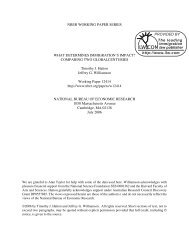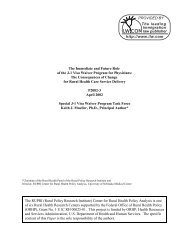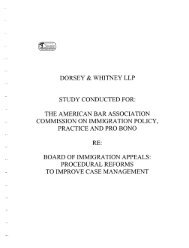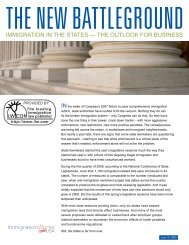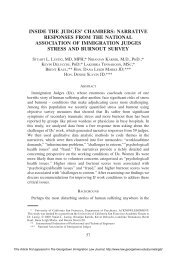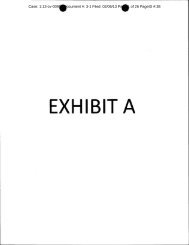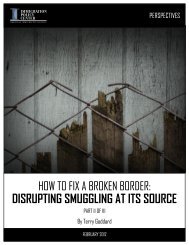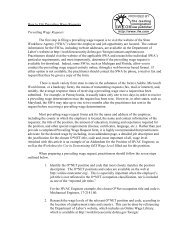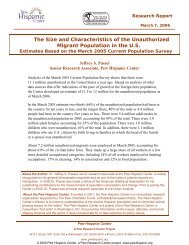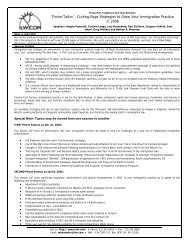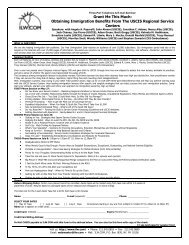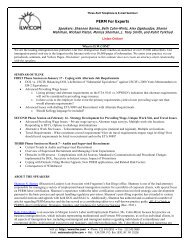IN THE UNITED STATES DISTRICT COURT FOR THE ... - ILW.com
IN THE UNITED STATES DISTRICT COURT FOR THE ... - ILW.com
IN THE UNITED STATES DISTRICT COURT FOR THE ... - ILW.com
You also want an ePaper? Increase the reach of your titles
YUMPU automatically turns print PDFs into web optimized ePapers that Google loves.
Case 2:09-cv-00240-LDD Document 168 Filed 03/21/13 Page 1 of 23<br />
<strong>IN</strong> <strong>THE</strong> <strong>UNITED</strong> <strong>STATES</strong> <strong>DISTRICT</strong> <strong>COURT</strong><br />
<strong>FOR</strong> <strong>THE</strong> EASTERN <strong>DISTRICT</strong> OF PENNSYLVANIA<br />
COMITE DE APOYO A LOS : CIVIL ACTION<br />
TRABAJADORES AGRICOLAS, et. al. :<br />
:<br />
v. :<br />
:<br />
HILDA SOLIS, in her official capacity as : NO. 09-240<br />
United States Secretary of Labor, et. al. :<br />
Legrome D. Davis, J. March 21, 2013<br />
OP<strong>IN</strong>ION<br />
Plaintiffs Comité de Apoyo a los Trabajadores Agrícolas (“CATA”), Pineros y<br />
Campesinos Unidos del Noroeste (“PCUN”), Alliance of Forest Workers and Harvesters (“the<br />
Alliance”), and Salvador Martinez Barrera challenge federal regulations promulgated by<br />
Defendant agency, the Department of Labor. The case is now before the Court on Plaintiff’s<br />
Motion for Permanent Injunctive Relief. (Doc. No. 152).<br />
I. Factual Background<br />
a. The H-2B Program<br />
The H-2B visa program—named for the statutory section under which it was created 1 —<br />
allows United States employers to bring foreign workers (“H-2B workers”) to the United States<br />
to perform temporary, unskilled, non-agricultural work. The H-2B program is distinct from the<br />
H-1B worker program, which permits aliens to temporarily enter the United States to perform<br />
skilled, “specialty occupations,” and from the H-2A program, which permits aliens to<br />
temporarily enter the United States to perform unskilled, agricultural labor.<br />
1 Immigration and Nationality Act, Pub. L. No. 82-414, § 101(a)(15)(H)(ii)(B), 66 Stat. 163, 168<br />
(1952), 8 U.S.C. § 1101(a)(15)(H)(ii)(B) (“<strong>IN</strong>A”).<br />
1
Case 2:09-cv-00240-LDD Document 168 Filed 03/21/13 Page 2 of 23<br />
The H-2B program is the result of significant political <strong>com</strong>promise. The program seeks to<br />
balance certain industries’ temporary need for unskilled foreign workers against a policy interest<br />
in protecting United States workers’ jobs, salaries, and working conditions. In furtherance of<br />
these dual considerations, the Immigration and Nationality Act (<strong>IN</strong>A) permits the issuance of H-<br />
2B visas, only where inter alia: (1) unemployed persons capable of performing such services<br />
cannot be found in this country; and (2) the employment of such aliens will not adversely affect<br />
the wages and working conditions of United States workers. 8 U.S.C. § 1101(a)(15)(H)(ii)(B); 8<br />
U.S.C. § 1182 (a)(5)(A)(i)(I)-(II).<br />
b. Administration of the H-2B Program<br />
The H-2B program is administered by the Department of Homeland Security (DHS) in<br />
conjunction with the Department of Labor (DOL).<br />
The <strong>IN</strong>A confers broad authority upon the DHS to admit aliens to this country and to<br />
promulgate regulations regarding the issuance of nonimmigrant visas. 2 The statute further<br />
provides that: “[t]he question of importing any alien as a nonimmigrant . . . in any specific case<br />
2 8 U.S.C. § 1184 (a)(1) (“[t]he admission to the United States of any alien as a nonimmigrant<br />
shall be for such a time and under such conditions as [the DHS] may by regulations prescribe”).<br />
The <strong>IN</strong>A’s original language refers to the Attorney General’s authority to regulate the H-2B<br />
program, but today the program is jointly regulated by the DHS and the DOL. When the DOL<br />
was first created in 1913, it housed the Bureau of Immigration and the Bureau of Naturalization.<br />
See Act of Mar. 4, 1913, Pub. L. No. 426-62, § 3, 37 Stat. 736, 737. As early as 1917, the<br />
Secretary of Labor and the Bureau of Immigration, then part of the DOL, worked together to<br />
manage the importation of laborers into the United States. See Immigration Act, Pub. L. No. 64-<br />
301, ch. 29, 39 Stat. 874, 877-78 (1917). In 1933, the two bureaus were consolidated to form<br />
the Immigration and Naturalization Service (“<strong>IN</strong>S”), which remained part of the DOL. See<br />
Exec. Order No. 6166, § 14 (June 10, 1933), reprinted at 5 U.S.C. §§ 124-132 (1940 ed.). The<br />
<strong>IN</strong>S was transferred to the Department of Justice in 1940, see Reorganization Plan No. V of<br />
1940, reprinted at 5 U.S.C. app. at 545 (2006 ed.), and remained there until it was dissolved by<br />
the Homeland Security Act of 2002. See Pub. L. No. 107-296, § 471, 116 Stat. 2135, 2205. In<br />
the Homeland Security Act, Congress further transferred jurisdiction to enforce and administer<br />
the immigration laws from the Attorney General and the <strong>IN</strong>S to the DHS and its agencies.<br />
Authority to adjudicate nonimmigrant visa petitions, including H-2B petitions, now rests with<br />
United States Citizenship and Immigration Services, an agency within the DHS. 6 U.S.C. § 271.<br />
2
Case 2:09-cv-00240-LDD Document 168 Filed 03/21/13 Page 3 of 23<br />
or specific cases shall be determined by [the DHS], after consultation with appropriate agencies<br />
of the Government.” 8 U.S.C. § 1184(c)(1).<br />
In accordance with the <strong>IN</strong>A, DHS regulations require that the Secretary of Labor<br />
determine and certify to the DHS that H-2B applications <strong>com</strong>port with the <strong>IN</strong>A’s requirements.<br />
Accordingly, prior to filing an H-2B petition with the DHS, an employer must first apply for and<br />
receive a temporary labor certification from the Secretary of Labor. 8 C.F.R. § 214.2 (h)(6)(iii)<br />
(2011). Such certification constitutes the DOL’s “advice” that the DHS should grant the<br />
requested H-2B visa and the certification must confirm that: (1) qualified workers in the United<br />
States are not available to perform the position sought; and (2) the alien's employment will not<br />
adversely affect wages and working conditions of similarly employed United States workers. 8<br />
C.F.R. § 214.2 (h)(6)(iii)(A), (iv)(A). DHS regulations instruct that the DOL shall “establish<br />
procedures” for administering labor certifications within these confines. 8 C.F.R. § 214.2<br />
(h)(6)(iii)(D).<br />
c. Prevailing Wages<br />
In order to issue a labor certification, the DOL must determine as a threshold matter, that<br />
qualified United States workers are not available to fill the position for which an employer seeks<br />
foreign workers. As the availability of United States workers is, for obvious reasons, largely<br />
determined by the wages that an employer offers, the DOL may only issue labor certifications<br />
where United States workers are unavailable to fill a given position at the occupation’s<br />
“prevailing wage.” Labor Certification Process and Enforcement for Temporary Employment in<br />
Occupations Other Than Agriculture or Registered Nursing in the United States (H-2B Workers),<br />
and Other Technical Changes, 73 Fed. Reg. 78020-01, 78056 (as codified at 20 C.F.R. §<br />
655.10(b)(2)) (Dec. 19, 2008). Accordingly, to apply for a labor certification, an employer must<br />
3
Case 2:09-cv-00240-LDD Document 168 Filed 03/21/13 Page 4 of 23<br />
first obtain from the DOL a prevailing wage determination for the area of intended employment,<br />
submit a work order with a state workforce agency serving the geographical area of intended<br />
employment, and advertise the position at a wage equal to or higher than the prevailing wage, as<br />
established by the DOL. Id. at 78022–23.<br />
i. Calculation of Prevailing Wages<br />
The DOL’s calculation of prevailing wages is of central importance to the H-2B<br />
program’s success. Nonetheless, over the past three decades, the DOL has periodically changed<br />
its method for calculating prevailing wages, without notice and <strong>com</strong>ment, and often without<br />
explanation.<br />
From about 1986 until 2008, 3 the DOL issued a series of guidance letters governing the<br />
calculation of H-2B prevailing wages. The DOL’s initial guidance letters charged state<br />
workforce agencies with making prevailing wage determinations for H-2B occupations, and<br />
provided that, in the absence of a collective bargaining agreement, state agencies should use the<br />
methodologies set forth in the Davis-Bacon Act (“DBA”), 4 and the McNamara-O’Hara Service<br />
Contract Act (“SCA”), 5 to determine prevailing wages. 6 Under this system, state workforce<br />
agencies calculated a single prevailing wage for any given occupation in the area of intended<br />
employment.<br />
3 A single program called the H-2 visa program formerly en<strong>com</strong>passed the recruitment of<br />
unskilled foreign workers for both agricultural and non-agricultural jobs, and the DOL issued<br />
regulations that governed the program—including its non-agricultural <strong>com</strong>ponent. Immigration<br />
and Nationality Act (“<strong>IN</strong>A”), Pub. L. No. 82-414, § 101(a)(15)(H)(ii), 66 Stat. 163, 168 (1952)<br />
(creating H-2 visa program). Congress bifurcated the H-2 visa program in 1986 into the H-2A<br />
program, for agricultural workers, and the H-2B program, for unskilled, non-agricultural<br />
workers. Immigration Reform and Control Act of 1986 (“IRCA”), Pub. L. No. 99-603 § 301(a),<br />
100 Stat. 3359, 3411.<br />
4 40 U.S.C. §§ 276a.<br />
5 41 U.S.C. §§ 6701 (formerly 41 U.S.C. §§ 351-358).<br />
6 Interim Prevailing Wage Policy for Nonagricultural Immigration Programs, Gen. Admin. Ltr.<br />
No. 4-95, at 1-2 (1995).<br />
4
Case 2:09-cv-00240-LDD Document 168 Filed 03/21/13 Page 5 of 23<br />
In the mid-1990s, the DOL altered its wage methodology to create multiple prevailing<br />
wages for each H-2B occupation. The DOL initially divided each H-2B occupation into two skill<br />
levels— “entry level”(“Level I”) or “experienced level” (“Level II”)—and calculated a<br />
prevailing wage for each level. 7 In 2005, the DOL further divided unskilled, H-2B occupations<br />
into four skill and wage levels, 8 borrowing from a system that Congress created to calculate<br />
prevailing wages for the H-1B program’s skilled, “specialty occupations.” 9 Both of these<br />
changes were achieved through DOL guidance letters and were not subject to notice and<br />
<strong>com</strong>ment rulemaking.<br />
ii. The 2008 Regulations<br />
On December 19, 2008, the DOL first promulgated regulations to govern H-2B labor<br />
certification. 10 The 2008 regulations alter H-2B certification in a number of significant ways.<br />
Importantly, the DOL adopted the “2008 Wage Rule” which states: “the prevailing wage for<br />
labor certification purposes shall be the arithmetic mean . . . of the wages of workers similarly<br />
employed at the skill level in the area of intended employment.” 11<br />
It is undisputed that, in applying the 2008 Wage Rule’s phrase “at the skill level,” the<br />
DOL uses the four-tier methodology that Congress created for the H-1B program and which the<br />
DOL adopted without notice and <strong>com</strong>ment in 2005. That is, under the 2008 Prevailing Wage<br />
7 Id. at 5-6.<br />
8 Mem. to SWA Adm’rs from Emily Stover DeRocco, Asst. Sec’y for Emp’t & Training,<br />
Revised Prevailing Wage Determination Guidance (May 17, 2005).<br />
9 Pub. L. No. 108-447, div. J, tit. IV, § 423, 118 Stat. 2809, 3353-54 (codified at 8 U.S.C. §<br />
1182(p)(4)).<br />
10 Labor Certification Process and Enforcement for Temporary Employment in Occupations<br />
Other Than Agriculture or Registered Nursing in the United States (H-2B Workers), and Other<br />
Technical Changes, 73 Fed. Reg. 78020-01 (as codified at 20 C.F.R. § 655.10(b)(2)) (Dec. 19,<br />
2008).<br />
11 73 Fed. Reg. at 78056 (emphasis added). If there is an applicable collective bargaining<br />
agreement, the wage rate in that agreement is used as the “prevailing wage.” Employers may<br />
submit their own wage data if certain conditions are met.<br />
5
Case 2:09-cv-00240-LDD Document 168 Filed 03/21/13 Page 6 of 23<br />
Rule, the DOL divides each unskilled, H-2B occupation into four separate skill levels and<br />
calculates a prevailing wage for each level. With this rule in place, the DOL grants labor<br />
certifications for H-2B workers, so long as “qualified” United States workers are not available at<br />
the “prevailing wage,” in the area of intended employment and at the particular skill level<br />
sought. The vast majority of employers who apply for H-2B labor certifications seek workers at<br />
an occupation’s lowest skill and wage level. 12<br />
II.<br />
Procedural History<br />
a. Generally<br />
Plaintiffs initiated the instant litigation in 2009, challenging various aspects of the DOL’s<br />
2008 regulations as improperly promulgated under the Administrative Procedure Act (APA). 13<br />
Among those provisions that Plaintiffs challenged was the 2008 Wage Rule.<br />
b. Invalidation of the 2008 Wage Rule<br />
On August 30, 2010, Honorable Louis H. Pollak of the Eastern District of Pennsylvania<br />
held that the DOL improperly promulgated the 2008 Wage Rule’s “at the skill level” language.<br />
Comite De Apoyo a Los Trabajadores Agricolas v. Solis, No. 09-240, 2010 WL 3431761 (E.D.<br />
Pa. Aug. 30, 2010). Judge Pollak reasoned:<br />
In the absence of any valid regulatory language authorizing the use of skill levels<br />
in determining the prevailing wage rate [ ] the four-tier structure of skill levels set<br />
out in the guidance letters—which is entirely untethered from any other statutory<br />
or regulatory provisions, and which affirmatively creates the wages paid to H–2B<br />
workers—constitutes a legislative rule which must be subjected to notice and<br />
<strong>com</strong>ment. It has not been so subjected and it [ ] is therefore invalid.<br />
12 Wage Methodology for the Temporary Non-agricultural Employment H-2B Program, 76 Fed.<br />
Reg. 3452-0176, 3463 (Jan. 19, 2011) (stating that almost 75% of DOL prevailing wage<br />
determinations regard Level I wages—wages based on the mean of the bottom one-third of all<br />
reported wages in an given occupation).<br />
13 This action was originally assigned to Judge Louis H. Pollak but was transferred to this Court<br />
on May 16, 2012, following Judge Pollak’s death.<br />
6
Case 2:09-cv-00240-LDD Document 168 Filed 03/21/13 Page 7 of 23<br />
Id. at *19. In invalidating the words “at the skill level,” the Court stressed that the “DOL has<br />
never explained its reasoning for using skill levels as part of H-2B prevailing wage<br />
determinations” and that the system has never been subject to notice and <strong>com</strong>ment, as the APA<br />
requires. Id. at *19, *25.<br />
Judge Pollak further found that the DOL’s errors in promulgating the 2008 Wage Rule<br />
were “serious” and of a magnitude that counseled in favor of vacating the Regulation. Id. at *25<br />
(“while the use of skill levels in 20 C.F.R. § 655.10 is invalid for lack of a rational explanation,<br />
DOL's failure to provide an explanation for using skill levels in the H–2B program constitutes a<br />
recurring issue stretching over more than a decade, and DOL was, in the context of the 2009<br />
rulemaking, presented with <strong>com</strong>ments alleging fundamental problems with the use of skill levels<br />
in the H–2B program”). Nonetheless, as the Court invalidated the Regulation due to the DOL’s<br />
procedural errors, Judge Pollak did not vacate the 2008 Wage Rule’s skill-level methodology,<br />
thereby circumventing a potentially unnecessary regulatory gap. Id. Judge Pollak remanded the<br />
Rule to the DOL and ordered that the DOL validly promulgate a replacement regulation within<br />
120 days, pursuant to the APA’s procedures for notice and <strong>com</strong>ment rulemaking. Id.<br />
c. The 2011 Rule<br />
Following Judge Pollak’s August 30, 2010 opinion, the DOL initially engaged in efforts<br />
to validly promulgate a prevailing wage regulation. In doing so, the DOL issued a notice of<br />
proposed rulemaking. This notice stated that, following Judge Pollak’s August 30, 2010 opinion,<br />
the DOL independently concluded that the 2008 Wage Rule’s skill-level methodology did not<br />
<strong>com</strong>port with the DOL’s regulatory and statutory mandate, because the methodology did not<br />
produce “the appropriate wage necessary to ensure that U.S. workers are not adversely affected<br />
7
Case 2:09-cv-00240-LDD Document 168 Filed 03/21/13 Page 8 of 23<br />
by the employment of H-2B workers.” Wage Methodology for the Temporary Non-Agricultural<br />
Employment H-2B Program, 75 Fed. Reg. 61578-01, 61579 (October 5, 2010).<br />
Following notice and <strong>com</strong>ment, the DOL announced a revised prevailing wage regulation<br />
in January 2011 (“the 2011 Wage Rule”). Wage Methodology for the Temporary Nonagricultural<br />
Employment H-2B Program, 76 Fed. Reg. 3452-0176 (Jan. 19, 2011). The 2011<br />
Wage Rule’s preamble explains that the Rule was promulgated in response to findings that the<br />
2008 Wage Rule “artificially lowers [ ] wage[s] to a point that [they] no longer represent[ ]<br />
market-based wage[s] for the occupation.” Id. at 3477. The document reasons:<br />
The predominance of Level I wages in the program, wages based on the mean of<br />
the bottom one-third of all reported wages in the systems, is itself evidence of the<br />
adverse impact of those wages on those U.S. workers performing the same tasks<br />
and engaged in the same jobs. Specifically, a review of the Department's records<br />
for the issuance of prevailing wages in calendar year 2010 indicates that almost<br />
75 percent of jobs are classified at a Level I wage, with the remaining 25 percent<br />
scattered in Levels II, III and IV. In a broader examination of wages offered over<br />
the past several years, in about 96 percent of cases, the H-2B wage is lower than<br />
the mean of the OES wage rates for the same occupation [ ]. In a low-skilled<br />
occupation, the mean for the occupation represents the wage that the average<br />
employer is willing to pay for unskilled workers to perform that job. The four-tier<br />
structure artificially lowers that wage to a point that it no longer represents a<br />
market-based wage for that occupation. The H-2B worker, along with the<br />
domestic workers recruited against the application, who are being paid a<br />
significantly lower wage than two-thirds of those in that area of employment<br />
cannot help but have a depressive effect on the wages of those around him. An<br />
employer paying U.S. workers as well as H-2B workers has no incentive to pay<br />
the U.S. workers any higher <strong>com</strong>pensation. The local <strong>com</strong>petitors, by extension,<br />
have no incentive to pay a higher <strong>com</strong>pensation. Therefore, it follows that if the<br />
employer must only offer and pay Level I wages, wages below what the average<br />
similarly employed worker is paid, those wages will make the U.S. workers less<br />
likely to accept those job opportunities or will require them to accept the job at a<br />
wage rate less than the market has determined is prevailing for the job. The net<br />
result is an adverse effect on the worker's in<strong>com</strong>e.<br />
Id. at 3463. The 2011 Rule’s preamble concludes: “continuing the current calculation<br />
methodology… does not provide adequate protections to U.S. and H-2B workers,” thereby<br />
violating both the <strong>IN</strong>A and the DHS’ mandates. Id. at 3471, 3477.<br />
8
Case 2:09-cv-00240-LDD Document 168 Filed 03/21/13 Page 9 of 23<br />
d. Delays in Enforcing the 2011 Rule<br />
Despite acknowledging the 2008 Wage Rule’s substantive flaws, the DOL has not yet<br />
implemented the 2011 Wage Rule and continues to use the 2008 Wage Rule.<br />
The DOL initially set January 1, 2012 as the 2011 Wage Rule’s effective enforcement<br />
date—almost a full year following the Rule’s publication. Id. at 3452. On June 15, 2011,<br />
however, Judge Pollak vacated the January 1, 2012 enforcement date and ordered that the DOL<br />
announce an earlier effective date within 45 days. Comite De Apoyo a Los Trabajadores<br />
Agricolas v. Solis, No. 09-240, 2011 WL 2414555 (E.D. Pa. June 16, 2011). In response to<br />
Judge Pollak’s Order, the DOL set the Rule to take effect on September 30, 2011. Nonetheless,<br />
the DOL has since postponed the Rule’s effective date on four subsequent occasions. 14 Most<br />
recently, the DOL postponed the Rule’s effective date until March 27, 2013 and now represents<br />
that additional delays are expected. 15<br />
The DOL’s three most recent postponements respond to appropriations concerns. On<br />
November 18, 2011, Congress passed the Consolidated and Further Continuing Appropriations<br />
Act. Consolidated and Further Continuing Appropriations Act, 2012, Pub. L. No. 112-55, 125<br />
Stat 552, Div. B, Title V, § 546 (2011). A rider to this Act contains language that bars the DOL<br />
from expending funds to implement the 2011 Wage Rule. The conference report ac<strong>com</strong>panying<br />
the Act states that the purpose of the postponement is to “allow congress to address” the 2011<br />
Wage Rule. H.R. Rep. No. 112-284 (2011) (Conf. Rep.). The report further directs the DOL to<br />
14 Wage Methodology for the Temporary Non-Agricultural Employment H-2B Program; Delay<br />
of Effective Date; Impact on Prevailing Wage Determinations, 76 Fed. Reg. 82116-01 (Dec. 30,<br />
2011); Wage Methodology for the Temporary Non-Agricultural Employment H-2B Program;<br />
Delay of Effective Date, 76 Fed. Reg. 73508-01 (Nov. 29, 2011); Wage Methodology for the<br />
Temporary Non-Agricultural Employment H-2B Program; Postponement of Effective Date, 76<br />
Fed. Reg. 59896-01 (Sept. 28, 2011).<br />
15 Wage Methodology for the Temporary Non-Agricultural Employment H-2B Program; Delay<br />
of Effective Date, 77 Fed. Reg. 60040-01 (Oct. 2, 2012).<br />
9
Case 2:09-cv-00240-LDD Document 168 Filed 03/21/13 Page 10 of 23<br />
continue using the 2008 Wage Rule until January 1, 2012. Id. Since November 18, 2011, two<br />
additional appropriations riders have denied funding for the 2011 Wage Rule. Consolidated<br />
Appropriations Act, 2012, Pub. L. No. 112-74, 125 Stat. 786, Div. F, Title I § 110 (2011);<br />
Continuing Appropriations Resolution, 2013, Pub. L. No. 112-175, 126 Stat 1313 (2012). These<br />
riders have not, however, directed that the DOL continue utilizing the invalidated 2008 Wage<br />
Rule or any other specific wage methodology. Id. Moreover, Congress has not acted to “address”<br />
the 2011 Wage Rule since passing the Consolidated and Further Continuing Appropriations Act<br />
in November 2011, and the parties anticipate that such action is unlikely.<br />
The DOL now continues to use the 2008 Wage Rule, nearly thirty (30) months after<br />
Judge Pollak invalidated the Rule, and two years after the DOL found that the Rule violates the<br />
DOL’s statutory and regulatory mandates. While the DOL anticipates continued barriers to<br />
funding the 2011 Rule, the DOL has not engaged in any efforts to promulgate a new regulation<br />
or to otherwise validly grant H-2B labor certifications. Hr’g Tr. 26:13–28:5; 21:11–23:23, Nov.<br />
28, 2012. Plaintiffs now move this Court to vacate the 2008 Wage Rule and to bar its continued<br />
use.<br />
III.<br />
Discussion<br />
In its current posture, this case presents a narrow question: Whether the DOL’s continued<br />
use of the 2008 Wage Rule—which has been found procedurally invalid by this Court and<br />
substantively invalid by the DOL—justifies vacating the Rule and barring the Rule’s continued<br />
use. For the reasons set forth below, we answer this question affirmatively.<br />
a. Judicial Review of Agency Action<br />
Section 706 of the APA governs judicial review of agency action. Section 706(2)<br />
empowers a court to “hold unlawful and set aside” agency action that the court finds, inter alia:<br />
10
Case 2:09-cv-00240-LDD Document 168 Filed 03/21/13 Page 11 of 23<br />
(A) Arbitrary, capricious, an abuse of discretion, or otherwise not in accordance with law;<br />
. . .<br />
(C) In excess of statutory jurisdiction, authority, or limitations, or short of statutory right;<br />
or<br />
(D) Without observance of procedure required by law.<br />
Judicial review under the APA focuses on the agency's decision-making process, not on<br />
the decision itself. NVE, Inc. v. Dep't of Health & Human Servs., 436 F.3d 182, 190-91 (3d Cir.<br />
2006). While “a court is not to substitute its judgment for that of the agency,” in an APA<br />
challenge, the court must ensure that the agency has properly applied APA rulemaking<br />
procedures and reached a rational conclusion. Motor Vehicle Mfrs. Ass'n of the United States,<br />
Inc. v. State Farm Mut. Auto. Ins. Co., 463 U.S. 29, 43, 103 S.Ct. 2856, 77 L.Ed.2d 443 (1983).<br />
Section 706 provides separate standards of review for procedural and substantive agency errors.<br />
Nonetheless, the line between procedure and substance is not always clear, and errors in<br />
procedural decision-making are often indicative of underlying substantive errors.<br />
i. Procedural Review<br />
1. Standard of Review<br />
Section 706(2)(D) of the APA provides that a court shall “hold unlawful and set aside”<br />
agency action that is, “[w]ithout observance of procedure required by law.” 5 U.S.C. §<br />
706(2)(D). Courts ubiquitously understand Section 706(2)(D) to require that a reviewing court<br />
invalidate agency regulations that do not <strong>com</strong>port with the APA’s rulemaking procedures. See,<br />
e.g., W.C. v. Bowen, 807 F.2d 1502, 1505 (9th Cir. 1987) (“An agency rule which violates the<br />
APA is void … Agency action taken under a void rule has no legal effect.”).<br />
2. Discussion<br />
11
Case 2:09-cv-00240-LDD Document 168 Filed 03/21/13 Page 12 of 23<br />
On August 30, 2010, Judge Pollak held that the DOL invalidly promulgated the 2008<br />
Wage Rule’s “at the skill level” language, because the Rule was not subject to public notice and<br />
<strong>com</strong>ment, as the APA requires. Comite De Apoyo A Los Trabajadores Agricolas v. Solis, No.<br />
09-240, 2010 WL 3431761 at *19 (E.D. Pa. Aug. 30, 2010). Judge Pollak accordingly<br />
invalidated the Rule under Section 706(2)(D).<br />
As Judge Pollak invalidated the 2008 Wage Rule solely due to the DOL’s procedural<br />
errors, Judge Pollak did not vacate the Regulation. 16 Rather, Judge Pollak remanded the Rule to<br />
the DOL and ordered that the DOL validly promulgate a replacement regulation within 120 days.<br />
Id. In remanding the Rule without vacatur, Judge Pollak circumvented a potentially unnecessary<br />
regulatory gap; yet, he acknowledged that where a regulation constitutes a clear misinterpretation<br />
or violation of governing law, vacatur is the appropriate remedy. Id. (vacating a portion of the<br />
2008 Regulations requiring only job contractors—and not their employer clients—to file<br />
applications for labor certifications, as violative of the clear language of DHS's governing<br />
regulations).<br />
ii. Substantive Review<br />
16 In remanding the 2008 Prevailing Wage Rule, Judge Pollak adopted the framework set out by<br />
the D.C. Circuit in Allied–Signal Inc. v. U.S. Nuclear Regulatory Comm'n., 988 F.2d 146, 150–<br />
51 (D.C. Cir.1993) (holding that in determining whether to vacate regulations that violate the<br />
APA, a court should consider “the seriousness of the [rule's] deficiencies (and thus the extent of<br />
doubt whether the agency chose correctly) and the disruptive consequences of an interim change<br />
that may itself be changed.”). In applying Allied-Signal, Judge Pollak acknowledged that<br />
“[n]either the Supreme Court nor the Third Circuit has ruled on the specific permissibility of the<br />
D.C. Circuit's approach.” Id. Judge Pollak further found that, where a regulation constitutes a<br />
clear misinterpretation or violation of governing law, vacatur is the appropriate remedy. Id.<br />
(vacating a portion of the 2008 Regulations requiring only job contractors, and not their<br />
employer clients, to file applications for labor certifications as violative of the clear language of<br />
DHS's governing regulations).<br />
12
Case 2:09-cv-00240-LDD Document 168 Filed 03/21/13 Page 13 of 23<br />
Section 706(2) of the APA further empowers a court to “hold unlawful and set aside”<br />
agency action that the court finds: (1) “[i]n excess of statutory jurisdiction, authority, or<br />
limitations, or short of statutory right”; or (2) “[a]rbitrary, capricious, an abuse of discretion, or<br />
otherwise not in accordance with law.” 5 U.S.C. §§ 706(2)(A), (C).<br />
Agency regulations are extensions of the legislative process and carry the force and effect<br />
of law. Nonetheless, as agencies acquire their rulemaking authority from specific statutory<br />
provisions, an agency “may not exercise its authority in a manner that is inconsistent with the<br />
administrative structure that Congress enacted into law,” regardless of the importance of the<br />
problem that an agency seeks to address. Food & Drug Admin. v. Brown & Williamson Tobacco<br />
Corp., 529 U.S. 120, 125, 120 S. Ct. 1291, 1297, 146 L. Ed. 2d 121 (2000) (citing ETSI Pipeline<br />
Project v. Missouri, 484 U.S. 495, 517, 108 S.Ct. 805, 98 L.Ed.2d 989 (1988); Chevron U.S.A.<br />
v. Natural Res. Def. Council, Inc., 467 U.S. 837, 842-43, 104 S.Ct. 2778, 81 L.Ed.2d 694<br />
(1984)) (internal quotations omitted). The Supreme Court explains that, in order for a regulation<br />
to have “the force and effect of law” it is necessary to establish a “nexus between the<br />
regulation[ ] and some delegation of the requisite legislative authority by Congress.” Chrysler<br />
Corp. v. Brown, 441 U.S. 281, 304, 99 S. Ct. 1705, 1718, 60 L. Ed. 2d 208 (1979).<br />
1. Section 706(2)(C)<br />
a. Standard of Review<br />
Under APA Section 706(2)(C), an administrative agency may not act “[i]n excess of<br />
statutory jurisdiction, authority, or limitations, or short of statutory right.” 5 U.S.C. § 706(2)(C).<br />
Our evaluation of whether an agency has acted consistently with the limitations of its<br />
delegated authority “begins with a delineation of the scope of the [agency’s] authority and<br />
discretion.” Citizens to Preserve Overton Park, Inc. v. Volpe, 401 U.S. 402, 415-16, 91 S.Ct.<br />
13
Case 2:09-cv-00240-LDD Document 168 Filed 03/21/13 Page 14 of 23<br />
814, 823, 28 L.Ed.2d 136 (1971), abrogated on other grounds by Califano v. Sanders, 430 U.S.<br />
99, 97 S. Ct. 980, 51 L. Ed. 2d 192 (1977); Schilling v. Rogers, 363 U.S. 666, 676-77, 80 S.Ct.<br />
1288, 1295-96, 4 L.Ed.2d 1478 (1960); Wilkinson v. Abrams, 627 F.2d 650, 659-60 (3d Cir.<br />
1980). Our review focuses on whether we can reasonably conclude that the agency’s grant of<br />
authority contemplates the actions taken, and where an agency’s authority is limited to “a small<br />
range of choices,” we must determine whether the agency’s actions can be reasonably said to fall<br />
within that small range. Citizens to Preserve Overton Park, 401 U.S. at 415-16; see also Chrysler<br />
Corp., 441 U.S. at 308; NVE, Inc. v. Dep't of Health & Human Servs., 436 F.3d 182, 190-91 (3d<br />
Cir. 2006); Dow Chem. Co. v. U.S. E.P.A., 605 F.2d 673, 682 (3d Cir. 1979).<br />
b. Discussion<br />
The DOL’s role with regard to the H-2B program is to issue labor certifications. Such<br />
certifications constitute “advice” to the DHS that a particular H-2B application <strong>com</strong>ports with<br />
the <strong>IN</strong>A’s requirements and that the DHS should grant the requested H-2B visa. 8 C.F.R. § 214.2<br />
(h)(6)(iii)(A). The DOL’s authority to grant labor certifications is specific and narrow and<br />
derives directly from the <strong>IN</strong>A and from DHS regulations.<br />
The <strong>IN</strong>A specifies that the DHS may only issue H-2B visas, where inter alia: (1)<br />
unemployed persons capable of performing such services cannot be found in this country; and<br />
(2) the employment of such aliens will not adversely affect the wages and working conditions of<br />
United States workers. 8 U.S.C. § 1101(a)(15)(H)(ii)(B); 8 U.S.C. § 1182(a)(5)(A)(i)(I)-(II). The<br />
statute further provides that: “[t]he question of importing any alien as a nonimmigrant . . . in any<br />
specific case or specific cases shall be determined by [the DHS], after consultation with<br />
appropriate agencies of the Government.” 8 U.S.C. § 1184(c)(1).<br />
14
Case 2:09-cv-00240-LDD Document 168 Filed 03/21/13 Page 15 of 23<br />
In accordance with the <strong>IN</strong>A, the DHS names the DOL an agency with which it consults<br />
regarding the issuance of H-2B visas, and a DOL labor certification constitutes the DOL’s advice<br />
that the DHS should grant a particular H-2B visa. 8 C.F.R. § 214.2 (h)(6)(iii)(A). DHS<br />
regulations further reiterate that each DOL labor certification shall confirm that: (1) qualified<br />
workers in the United States are not available to perform the position sought; and (2) the alien's<br />
employment will not adversely affect wages and working conditions of similarly employed<br />
United States workers. 8 C.F.R. § 214.2 (h)(6)(iv)(A).<br />
Labor certifications issued under the 2008 Wage Rule exceed the DOL’s delegated<br />
authority. The <strong>IN</strong>A and DHS regulations define a small subset of individuals to whom the DOL<br />
may grant labor certifications if, and only if, the DOL can assure that such individuals’ receipt of<br />
H-2B visas will not adversely affect United States workers. While the DOL lacks authorization<br />
to issue labor certifications absent such assurance, the DOL acknowledges that certifications<br />
granted under the 2008 Wage Rule “artificially lower[ ] wage[s] to a point that [they] no longer<br />
represent[ ] market-based wage[s] for the occupation” and that such certifications “cannot help<br />
but have a depressive effect on the wages of [United States workers].” 76 Fed. Reg. 3452-0176,<br />
3477. Accordingly, labor certifications issued under the 2008 Wage Rule fall directly outside the<br />
narrow range of circumstances under which the DOL is authorized to issue labor certifications<br />
and exceed the bounds of the DOL’s delegated authority under Section 706(2)(C) of the APA.<br />
We therefore invalidate the 2008 Wage Rule under this provision.<br />
2. 706(2)(A)<br />
a. Standard of Review<br />
Under APA Section 706(2)(A) a legislative rule has no legal effect if it is arbitrary,<br />
capricious, or manifestly contrary to the statute. 5 U.S.C. § 706(2)(A); Chevron U.S.A., Inc. v.<br />
15
Case 2:09-cv-00240-LDD Document 168 Filed 03/21/13 Page 16 of 23<br />
Natural Res. Def. Council, Inc., 467 U.S. 837, 843-44, 104 S. Ct. 2778, 81 L. Ed. 2d 694 (1984).<br />
We further invalidate the 2008 Wage Rule under Section 706(2)(A).<br />
In determining whether a rule <strong>com</strong>ports with Section 706(2)(A), we must “give effect to<br />
the unambiguously expressed intent of Congress” and we must assure that the regulation<br />
harmonizes with the language of the statute, its origin, and its purpose. Food & Drug Admin. v.<br />
Brown & Williamson Tobacco Corp., 529 U.S. 120, 126, 120 S. Ct. 1291, 1297, 146 L. Ed. 2d<br />
121 (2000) (internal citations omitted); Sekula v. F.D.I.C., 39 F.3d 448, 452 (3d Cir. 1994).<br />
While an agency’s interpretation of a statute is generally given great deference, a regulation that<br />
conflicts with a statute’s plain language is not entitled to judicial deference. Chevron, 467 U.S. at<br />
843-44; K Mart Corp. v. Cartier, Inc., 486 U.S. 281, 292, 108 S. Ct. 1818, 100 L. Ed. 313 (1988).<br />
We conduct our substantive review of legislative rules under the arbitrary and capricious<br />
standard unless the source of an agency’s delegated authority <strong>com</strong>pels an alternate standard of<br />
review. Motor Vehicle Mfrs. Ass’n of U.S., Inc. v. State Farm Mut. Auto. Ins. Co., 463 U.S. 29,<br />
44, 103 S. Ct. 2856, 77 L. Ed. 2d. 443 (1983); Dickenson v. Secretary of Def., 68 F.3d 1396,<br />
1404 n. 12 (D.C. Cir. 1995); Mt. Graham Red Squirrel v. Espy, 986 F.2d 1568, 1571 (9th Cir.<br />
1993). To determine whether an agency acted arbitrarily and capriciously, we look to whether<br />
the agency relied on factors outside of those that Congress intended for consideration,<br />
<strong>com</strong>pletely failed to consider an important aspect of the problem, or provided an explanation that<br />
is contrary to, or implausible in light of, the evidence. Motor Vehicle Mfrs., 463 U.S. at 44;<br />
Pennsylvania Dep't of Pub. Welfare v. United States Dep't of Health and Human Servs., 101 F.3d<br />
939, 943 (3d Cir. 1996). Our review focuses on the agency’s decision-making process, rather<br />
than the decision itself, and we need only ensure that the agency has reached a rational<br />
conclusion. Motor Vehicle Mfrs. Ass'n, 463 U.S. at 43. Under this standard, a rule that is in<br />
16
Case 2:09-cv-00240-LDD Document 168 Filed 03/21/13 Page 17 of 23<br />
direct variance with an unambiguous statutory provision is void. See Brown & Williamson<br />
Tobacco Corp., 529 U.S. at 125-126; Sekula, 39 F.3d at 452 (3d Cir. 1994); Diersen v. Chicago<br />
Car Exchange, 110 F.3d 481, 486 (7th Cir. 1997), cert denied, 552 U.S. 868, 118 S. Ct. 178, 138<br />
L. Ed. 2d 119 (1997).<br />
b. Discussion<br />
Both the <strong>IN</strong>A and the DHS’ implementing regulations en<strong>com</strong>pass a number of difficult<br />
policy choices. Our role at this stage is not to determine whether these policy choices are<br />
desirable. Rather, our role is confined to assessing whether the 2008 Wage Rule gives effect to<br />
the unambiguous language of the legislation and regulations as drafted by Congress and the<br />
DHS. Dow Chem. Co. v. U.S. E.P.A., 605 F.2d 673, 689-90 (3d Cir. 1979).<br />
Viewing the <strong>IN</strong>A as a whole, it is evident that one of the Act’s core objectives is to<br />
balance certain industries’ temporary need for foreign workers against a policy interest in<br />
protecting United States workers’ jobs, salaries, and working conditions. This essential purpose<br />
pervades both the <strong>IN</strong>A and the DHS’ implementing regulations. For instance, Congress and the<br />
DHS explicitly preclude the grant of labor certifications to foreign workers whose employment<br />
may “adversely affect wages and working conditions of similarly employed United States<br />
workers.” 8 U.S.C. § 1182(a)(5)(A)(i)(II); 8 C.F.R. § 214.2 (h)(6)(iv)(A). Additionally, the <strong>IN</strong>A<br />
permits the DHS to impose civil monetary penalties upon H-2B employers who fail to <strong>com</strong>port<br />
with H-2B requirements, and the Statute instructs that “[i]n determining the level of penalties to<br />
be assessed … the highest penalties shall be reserved for willful failures to meet any of the<br />
conditions … that involve harm to United States workers.” 8 U.S.C. § 1184(c)(14)(A), (C).<br />
Here, Congress has directly spoken to the issue before us and has precluded the DOL<br />
from granting H-2B labor certifications absent confirmation that an “alien's employment will not<br />
17
Case 2:09-cv-00240-LDD Document 168 Filed 03/21/13 Page 18 of 23<br />
adversely affect wages and working conditions of similarly employed United States workers.” 8<br />
U.S.C. § 1101(a)(15)(H)(ii)(B); 8 U.S.C. § 1182 (a)(5)(A)(i)(I)-(II). Despite acknowledging this<br />
restriction, the DOL further acknowledges that the 2008 Wage Rule permits certifications which:<br />
(1) “artificially lower[ ] wage[s] to a point that [they] no longer represent [ ] market-based<br />
wage[s] for the occupation” and; (2) “have a depressive effect on the wages of [United States<br />
workers].” 76 Fed. Reg. 3452-0176, 3477. Such consequences plainly contradict congressional<br />
policy and render the 2008 Wage Rule invalid under Section 706(2)(A).<br />
b. Remedies<br />
Section 706(2) of the APA provides that a reviewing court shall “hold unlawful and set<br />
aside agency action” that violates the APA’s procedural or substantive provisions. 5 U.S.C. §<br />
706(2) (emphasis added). Courts traditionally understand Section 706(2) to mean that, when a<br />
reviewing court deems an agency regulation invalid, the court should vacate the rule and then<br />
remand the issue back to the agency for further review. Abington Mem. Hosp. v. Heckler, 750<br />
F.2d 242, 244 (3d Cir. 1984). By vacating an invalid rule, a reviewing court leaves the agency<br />
with four options: (1) reenact the same rule with an amended procedure or justification; (2)<br />
replace the rule with a substantively different rule; (3) request severance of the invalid portions<br />
of the rule from those portions deemed valid; or (4) abandon the rulemaking effort altogether.<br />
The DOL argues that we should not vacate the 2008 Wage Rule even though the Rule is<br />
procedurally and substantively invalid and violates three separate provisions of the APA. Rather,<br />
the DOL urges that we remand the issue back to the DOL for further consideration and leave the<br />
invalid 2008 Wage Rule in place in the interim. The DOL’s argument rests upon a line of D.C.<br />
Circuit cases, which find remand without vacatur appropriate under certain circumstances. See,<br />
e.g., Allied-Signal Inc. v. U.S. Nuclear Regulatory Comm’n, 988 F.2d 146 (D.C. Cir. 1993).<br />
18
Case 2:09-cv-00240-LDD Document 168 Filed 03/21/13 Page 19 of 23<br />
In assessing the appropriate remedy in this action, we note as a preliminary matter that<br />
this is hardly an ordinary case. The DOL has <strong>com</strong>e before this Court and expressly<br />
acknowledged the limits that the <strong>IN</strong>A and DHS regulations set upon its rulemaking authority.<br />
The DOL further acknowledges that the 2008 Wage Rule contradicts these limits. Nonetheless,<br />
after the DOL acknowledged the 2008 Wage Rule’s defects and promulgated an unsuccessful<br />
replacement rule, the DOL entirely stopped in its tracks. The DOL now expresses that it has no<br />
intention of taking further action to bring the DOL’s H-2B labor certification into statutory and<br />
regulatory <strong>com</strong>pliance and instead urges that we leave undisturbed a rule that this Court found<br />
procedurally invalid thirty months ago and that has since been declared substantively invalid by<br />
the very agency that now urges us to leave the Rule in place.<br />
The DOL correctly highlights that a line of D.C. Circuit cases finds remand without<br />
vacatur appropriate under certain circumstances. In this Court’s view, however, remand without<br />
vacatur is not easily squared with Section 706(2)’s seemingly mandatory language—which<br />
requires that we “hold unlawful and set aside agency action” that violates the APA. 17<br />
Importantly, neither the Supreme Court nor the Third Circuit has held that the APA permits a<br />
court to remand an invalid regulation without first vacating the regulation. See, e.g., Council<br />
Tree Communications, Inc. v. F.C.C., 619 F.3d 235, 258 n. 13 (3d Cir. 2010) (“we express no<br />
view as to whether we are authorized to order this remedy”).<br />
17 Courts also increasingly question this procedure’s practical implications for individual cases<br />
and its systematic effects on the balance of government powers. See, e.g., In re Core<br />
Communications, Inc., 531 F.3d 849, 862 (D.C. Cir. 2008) (Griffith, J., concurring) (“experience<br />
suggests that this remedy sometimes invites agency indifference”); Natural Res. Def. Council v.<br />
EPA, 489 F.3d 1250, 1262–64 (D.C. Cir. 2007) (Randolph, J., concurring) (“A remand-only<br />
disposition is, in effect, an indefinite stay of the effectiveness of the court's decision and agencies<br />
naturally treat it as such.”); Milk Train, Inc. v. Veneman, 310 F.3d 747, 758 (D.C. Cir. 2002)<br />
(Sentelle, J., dissenting) (declaring remand without vacatur unlawful).<br />
19
Case 2:09-cv-00240-LDD Document 168 Filed 03/21/13 Page 20 of 23<br />
Irrespective of the permissibility of the DOL’s request, we find that the facts of this case<br />
counsel in favor of vacating the 2008 Wage Rule. The practical effect of remand without vacatur<br />
is that an invalid rule remains in place while an agency works to correct its errors. This approach<br />
is often sensible where an agency promulgates a substantively valid rule through an invalid<br />
process and the agency will likely promulgate the same rule through a proper process on remand.<br />
Nonetheless, remand without vacatur is far less logical where, as here, a court finds that a rule<br />
directly contradicts an agency’s authority and the agency expresses no intention of timely<br />
correcting its error. In such circumstances, to leave an invalid rule in place is for a reviewing<br />
court to legally sanction an agency’s disregard of its statutory or regulatory mandate. Absent<br />
instruction that the APA permits such a remedy, we decline to grant the DOL’s seemingly<br />
irreconcilable request. See Food & Drug Admin. v. Brown & Williamson Tobacco Corp., 529<br />
U.S. 120, 123, 120 S. Ct. 1291, 1296, 146 L. Ed. 2d 121 (2000) (internal quotations and citations<br />
omitted) (“No matter how important, conspicuous, and controversial the issue … an<br />
administrative agency’s power to regulate … must always be grounded in a valid grant of<br />
authority … [and we] must take care not to extend the scope of the statute beyond the point<br />
where Congress indicated it would stop.”).<br />
We further note that we would decline to grant the DOL’s request even if we adopted the<br />
D.C. Circuit’s approach. The D.C. Circuit holds that, when a reviewing court finds an agency<br />
rule invalid, the court should weigh: (1) “the seriousness of the [rule’s] deficiencies (and thus the<br />
extent of doubt whether the agency chose correctly)” against (2) the “disruptive consequences”<br />
of vacatur. See Allied-Signal Inc. v. U.S. Nuclear Regulatory Comm’n, 988 F.2d 146, 150-51<br />
(D.C. Cir. 1993). If the disruptive consequences of vacatur outweigh an invalid rule’s<br />
20
Case 2:09-cv-00240-LDD Document 168 Filed 03/21/13 Page 21 of 23<br />
deficiencies, the D.C. Circuit finds that the reviewing court should remand the rule to the agency<br />
without first vacating the rule. Id.<br />
Allied-Signal’s first prong asks that we consider the seriousness of the DOL’s errors.<br />
With regard to the DOL’s procedural errors, Judge Pollak held that the “DOL has never<br />
explained its reasoning for using skill levels as part of H-2B prevailing wage determinations”<br />
and that the system has never been subject to notice and <strong>com</strong>ment, as the APA requires. Comite<br />
De Apoyo A Los Trabajadores Agricolas v. Solis, No. 09-240, 2010 WL 3431761 at *25 (E.D.<br />
Pa. Aug. 30, 2010). Judge Pollak further found that the DOL’s procedural errors were “serious”<br />
and of a magnitude that counseled in favor of vacating the Regulation. Id. at *25 (“[W]hile the<br />
use of skill levels in 20 C.F.R. § 655.10 is invalid for lack of a rational explanation, DOL's<br />
failure to provide an explanation for using skill levels in the H–2B program constitutes a<br />
recurring issue stretching over more than a decade, and DOL was, in the context of the 2009<br />
rulemaking, presented with <strong>com</strong>ments alleging fundamental problems with the use of skill levels<br />
in the H–2B program.”). Nonetheless, as the Court did not make findings regarding the<br />
substantive validity of the 2008 Wage Rule, Judge Pollak did not vacate the Rule, thereby<br />
circumventing a potentially unnecessary regulatory gap. Id.<br />
With regard to substantive errors, Allied-Signal’s first prong further asks that we consider<br />
“the extent of doubt whether the agency chose [its action] correctly.” 988 F.2d at 150-51. This<br />
language suggests that we should consider the likelihood that the agency can provide a valid<br />
explanation for its rule on remand. Here, as the 2008 Wage Rule directly contradicts the <strong>IN</strong>A’s<br />
statutory language and the DOL has independently concluded that the Rule contravenes its<br />
statutory and regulatory mandate, we find inconceivable that the DOL will proffer support for<br />
the 2008 Wage Rule on remand.<br />
21
Case 2:09-cv-00240-LDD Document 168 Filed 03/21/13 Page 22 of 23<br />
The DOL argues that, despite the 2008 Wage Rule’s procedural and substantive flaws,<br />
the disruptive consequences of vacatur outweigh the seriousness of the 2008 Wage Rule’s<br />
deficiencies. In support of this assertion, the DOL highlights that, when a rule is vacated, an<br />
agency generally reverts to the status quo ante (the prior rule). In this case, however, there is not<br />
a valid prior rule upon which the DOL can rely, because the DOL similarly violated the APA’s<br />
rulemaking procedures in creating the predecessor wage-regime. The DOL now argues that<br />
vacatur would be unusually disruptive, because the DOL’s history of APA violations has left the<br />
DOL without a valid regulatory mechanism with which to implement the H-2B program, thereby<br />
requiring that the DOL grant labor certifications on an individual, ad hoc basis until the DOL<br />
promulgates a valid rule.<br />
We find the DOL’s arguments unpersuasive. Although vacating the 2008 Rule might<br />
disrupt the H-2B program’s current structure, Congress has not granted the DHS and DOL<br />
unfettered authority to issue H-2B visas. Rather, in passing the <strong>IN</strong>A, Congress defined a small<br />
subset of individuals who may receive H-2B visas if, and only if, the DHS can ensure that such<br />
visas will not adversely affect United States workers. Absent this assurance, the DHS is not<br />
authorized to issue H-2B visas.<br />
Despite clear constraints on the DHS and DOL’s authority, the DOL explicitly finds that<br />
the 2008 Wage Rule creates cognizable adverse consequences for United States workers.<br />
Accordingly, our vacating the 2008 Wage Rule will only disrupt the H-2B program to the extent<br />
that the DHS and DOL use the program to issue H-2B visas that they are expressly prohibited<br />
from granting. In light of the extent and seriousness of the DOL’s errors, as well as the DOL’s<br />
representation that the DOL is not engaging in efforts to validly grant H-2B labor certifications,<br />
this consequence hardly <strong>com</strong>pels leaving the 2008 Wage Rule in place, even under the D.C.<br />
22
Case 2:09-cv-00240-LDD Document 168 Filed 03/21/13 Page 23 of 23<br />
Circuit’s jurisprudence. For the foregoing reasons, we find that vacatur of the 2008 Wage Rule is<br />
the only appropriate remedy under these unusual circumstances.<br />
IV.<br />
Conclusion<br />
For the foregoing reasons, Plaintiffs’ Motion for Permanent Injunctive Relief is<br />
GRANTED. The 2008 Wage Rule, 73 Fed. Reg. 78020-01, 78056 (as codified at 20 C.F.R. §<br />
655.10(b)(2)) (Dec. 19, 2008), is VACATED AND REMANDED to the Department of Labor.<br />
The DOL shall <strong>com</strong>e into <strong>com</strong>pliance within thirty (30) days. An appropriate Order has been<br />
filed separately.<br />
BY <strong>THE</strong> <strong>COURT</strong>:<br />
s/Legrome D. Davis<br />
Legrome D. Davis, J.<br />
23



